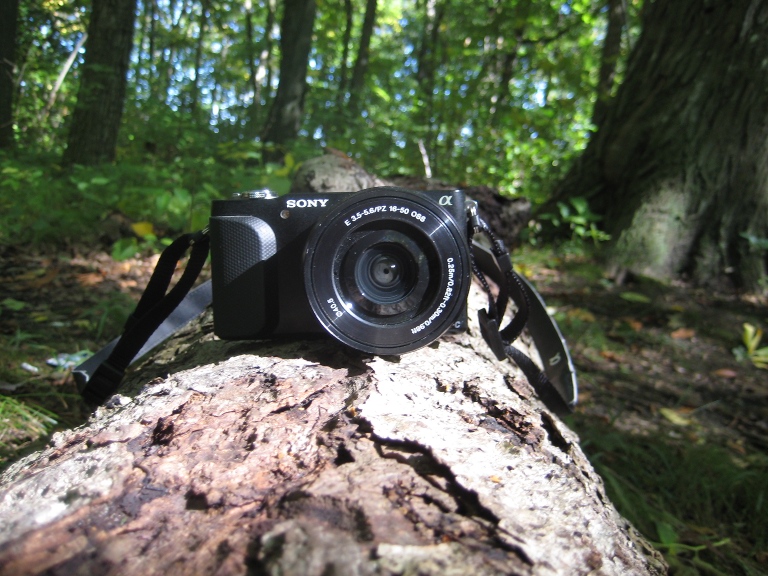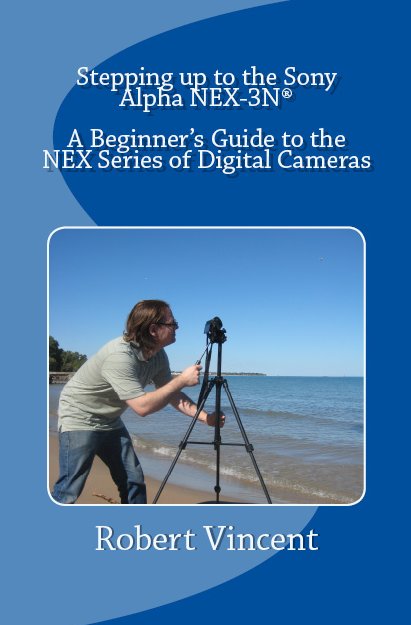
| Published: | October 18, 2013 (Paperback and Kindle) |
| Length: | 50 Pages (including photos) |
| Publisher: | RCV |
| Genre: | Instruction Manual |
| -
About the Book - From the Introduction |
|
All I knew is that my camera sucked. Beyond that, I wasn’t sure where to start. I just wanted to take good pictures. Is that so hard? Actually yes, because I not only wanted to take good pictures, but have the ability to capture fast moving objects in bad lighting crammed into a small form factor. The more I dug into it the more variables I found, until I had information running out of my ears. Finally after much searching I stepped up from my point and shoot to the Sony Alpha NEX-3N. I’m not a camera expert. However, in my search for this camera and in learning to use it, I have learned more than I ever thought I would about camera technology. In that time I have accumulated pages of notes, thousands of photos, and movie after movie where individual variables were changed in an effort to determine what effect each had on the final product. During this period I learned what is truly important to a beginner, and it is only as a novice myself that I realized how important these questions are to answer right from the beginning. This book is aimed at the individual stepping up from their camera phone or a regular point and shoot to this machine. Someone who might not know what an f-stop is or how it relates to the ISO settings or the aperture. Or what impact the lens has on any of this. Phase detect vs contrast detect auto-focus? Does it really matter? These are trial-by-fire questions you might not get an answer to until you spend the money on this unit and find out what impact they have in real world scenarios. Since purchasing this
camera I have read web pages, blogs, manuals, and quick guides all
about the NEX system. Though well written I never felt part of the
target audience. Answers to the questions I had seemed too simple for
them to cover, or the answers buried too deeply. So I created the book
that I wanted from the beginning to save me from the pitfalls I
experienced by rushing out the door unprepared. Mistakes that cost me
shots I will never have again. |
| -
Bonus Goodies - |
| The
large majority of the photos in the text have been cropped or resized
during the editing process. The purpose of this section though is
to
give a higher quality image than the one offered in the book for a more
thorough inspection. With the exception of the one full size
image
meant to show the detail captured by the NEX, all of the images have
been resized to be less than one megabyte for the purpose of bandwidth
conservation. Note: Images actually depicting the NEX-3N were taken with a Canon Powershot SD1000 Digital Elph. |
| Image
Name |
Page |
Comments |
| Back
Controls |
8 |
Detail of the controls on the
back of the NEX. Taken on a nice sunny day at the beach with the
camera on a tripod. Exposure Time - 1/125 sec,Aperture f/8.0, ISO
80 |
| Overhead
View |
10 |
Top-down view of the NEX sitting
on a table in my reading room. Exposure Time - 1/8 sec, Aperture
f/4.0, ISO 200 |
| Side
View |
11 |
Showing off the memory card slot
and the connection ports. Exposure Time - 1/8 sec, Aperture
f/4.9, ISO 200 |
| Front
Angled View |
12 |
Notice the IR lamp for helping
with the contrast based focus. Also note the push button to
unscrew
the lens. Exposure Time - 1/10 sec, Aperture f/2.8, ISO 200 |
| Camera
Display |
16 |
Reference numbers are in the
text. Shot of the display of the camera pointing at a solid red
object. Exposure Time - 1/3, Aperture f4.5, ISO 100 |
| Focus
Examples |
17 |
Focus on the foreground object
and the background object. Composite shot. |
| Aperture
Examples |
18 |
To highlight the differences
between a wide open (low f-stop) aperture setting and a high f-stop
setting. Composite shot. |
| Shutter
Speed Comaprison |
19 |
Example of a shot with a long
shutter speed and a different shot with a short shutter speed.
The
short speed was taken with a flash. The longer shot of the
fireworks
was taken using the BULB setting until I felt the moment was captured
just right. Composite shot. |
| Same
light metering, different shots |
21 |
These three shots were taken
with identical 0.0 light metering however with widely different
settings. Composite shot. Top Left Exposure Time 1/320,
Aperture
f/3.5, ISO 6400: Top Right Exposure Time 1/40, Aperture f/4.0, ISO 800,
Bottom Exposure Time 1/3, Aperture f/7.1, ISO 200 |
| Standard
Exposure HDR Exposure |
22 23 |
One shot with a standard
exposure (Exposure Time 1/640, Aperture Unknown, ISO 800) and that same
shot as part of a HDR image. |
| Panorama |
27 |
Panorama shot from bottom to top
of a tree. Stitched together in camera. |
| Full
Detail Garage |
32 |
Image processed by camera only,
full size as processed by camera. Honestly the image is not super
sharp showing the focus was slightly off. Exposure Time 1/160
sec, ISO
500 |
| White
Balance Issues |
34 |
Upper left and lower right had
white balances selected by me. Lower left and upper right were
the
white balances as automatically selected by the camera. The white
balance the camera selected was influenced by all the blue water.
Composite image. |
| Backlighting |
35 |
The multi-point light metering
that the camera defaults to will fail in a number of
circumstances. In
cases where the subject is lit from behind this is the general
result.
Exposure Time 1/250 sec, ISO 200 |
| Color
Accent Mode |
36 |
There are a number of in-camera
processing effects. This is one of the accent modes. There
are
several modes covering different colors. Exposure Time 1/80 sec,
ISO
200 |
| Fan
at 1/60 sec Fan at 0.4 sec |
40 |
When shooting a video in manual
mode your shutter speed becomes your frame rate. If you shoot
with too
long of a shutter speed your video will turn out completely different
(usually for the worse) although this does not affect the audio.
Each
image represents a frame from a video shots with that frame rate. |
| Subject with Vintage Yashinon Lens | 43 |
Subject shot with a vintage lens
on the camera. The lens had an aperture of f/1.7 and was shot
wide
open leading to the very out of focus background. Exposure Time
1/1250
sec, ISO 1250 |
Main page
You can contact me at via e-mail with any questions or comments.

All content copyright © Robert Vincent, All rights reserved (2015) except for the Amazon click button which is not mine at all, the CreateSpace logo (again note mine), and all terms relating to the Sony Alpha NEX system, those remain property of Sony of America. Thank you for looking!


